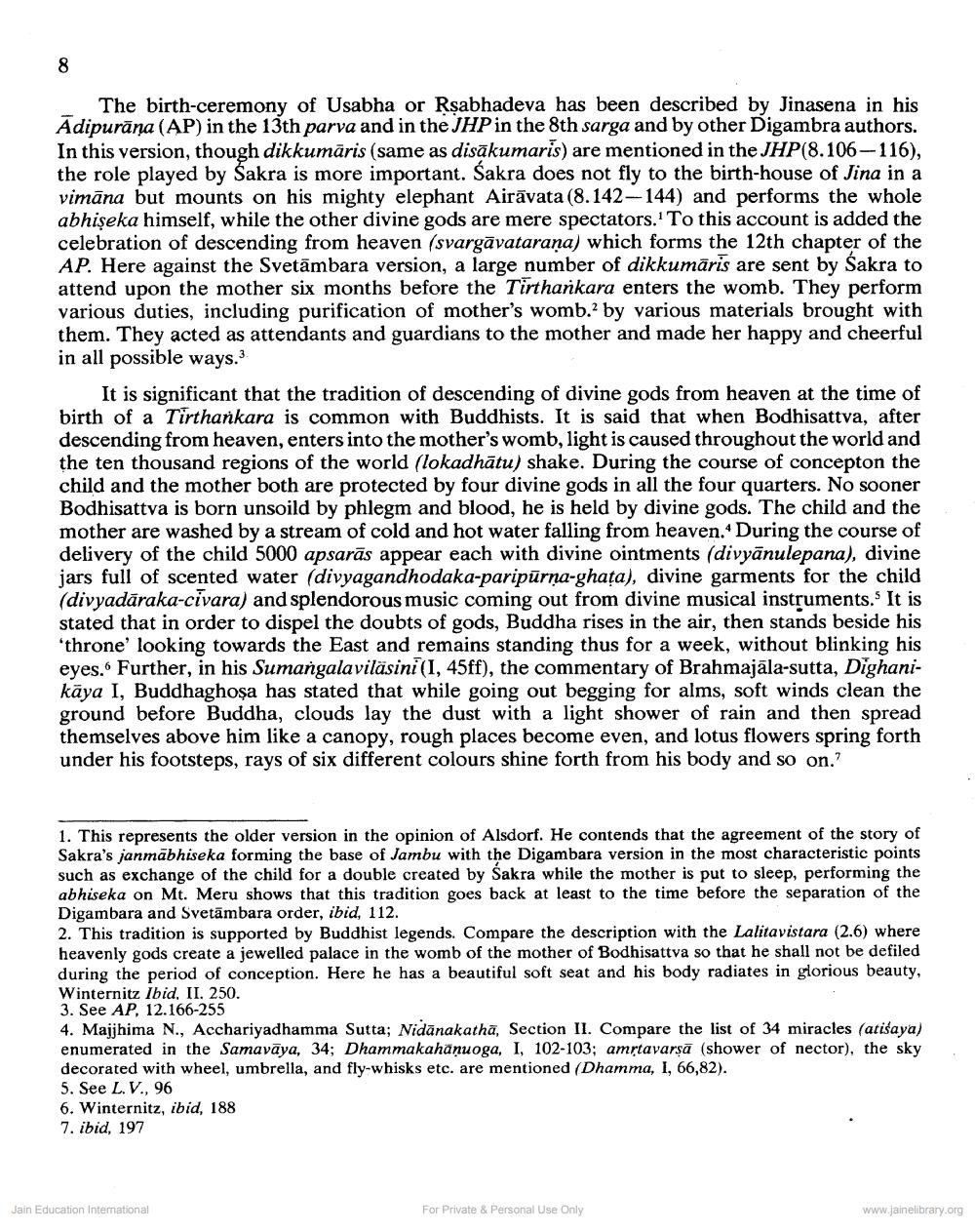________________
8
The birth-ceremony of Usabha or Rṣabhadeva has been described by Jinasena in his Adipurana (AP) in the 13th parva and in the JHP in the 8th sarga and by other Digambra authors. In this version, though dikkumaris (same as disākumaris) are mentioned in the JHP(8.106-116), the role played by Sakra is more important. Sakra does not fly to the birth-house of Jina in a vimana but mounts on his mighty elephant Airavata (8.142-144) and performs the whole abhişeka himself, while the other divine gods are mere spectators.' To this account is added the celebration of descending from heaven (svargavataraṇa) which forms the 12th chapter of the AP. Here against the Svetämbara version, a large number of dikkumaris are sent by Sakra to attend upon the mother six months before the Tirthankara enters the womb. They perform various duties, including purification of mother's womb.' by various materials brought with them. They acted as attendants and guardians to the mother and made her happy and cheerful in all possible ways.
It is significant that the tradition of descending of divine gods from heaven at the time of birth of a Tirthankara is common with Buddhists. It is said that when Bodhisattva, after descending from heaven, enters into the mother's womb, light is caused throughout the world and the ten thousand regions of the world (lokadhätu) shake. During the course of concepton the child and the mother both are protected by four divine gods in all the four quarters. No sooner Bodhisattva is born unsoild by phlegm and blood, he is held by divine gods. The child and the mother are washed by a stream of cold and hot water falling from heaven. During the course of delivery of the child 5000 apsaras appear each with divine ointments (divyānulepana), divine jars full of scented water (divyagandhodaka-paripūrṇa-ghata), divine garments for the child (divyadāraka-civara) and splendorous music coming out from divine musical instruments.' It is stated that in order to dispel the doubts of gods, Buddha rises in the air, then stands beside his 'throne' looking towards the East and remains standing thus for a week, without blinking his eyes. Further, in his Sumangalaviläsini (1, 45ff), the commentary of Brahmajäla-sutta, Dighanikāya I, Buddhaghosa has stated that while going out begging for alms, soft winds clean the ground before Buddha, clouds lay the dust with a light shower of rain and then spread themselves above him like a canopy, rough places become even, and lotus flowers spring forth under his footsteps, rays of six different colours shine forth from his body and so on.?
1. This represents the older version in the opinion of Alsdorf. He contends that the agreement of the story of Sakra's janmābhiseka forming the base of Jambu with the Digambara version in the most characteristic points such as exchange of the child for a double created by Sakra while the mother is put to sleep, performing the abhiseka on Mt. Meru shows that this tradition goes back at least to the time before the separation of the Digambara and Svetambara order, ibid, 112.
2. This tradition is supported by Buddhist legends. Compare the description with the Lalitavistara (2.6) where heavenly gods create a jewelled palace in the womb of the mother of Bodhisattva so that he shall not be defiled during the period of conception. Here he has a beautiful soft seat and his body radiates in glorious beauty, Winternitz Ibid. II. 250.
3. See AP, 12.166-255
4. Majjhima N., Acchariyadhamma Sutta; Nidānakathā, Section II. Compare the list of 34 miracles (atisaya) enumerated in the Samavaya, 34; Dhammakahaṇuoga, I, 102-103; amṛtavarṣā (shower of nector), the sky decorated with wheel, umbrella, and fly-whisks etc. are mentioned (Dhamma, I, 66,82).
5. See L. V., 96
6. Winternitz, ibid, 188
7. ibid, 197
Jain Education International
For Private & Personal Use Only
www.jainelibrary.org




